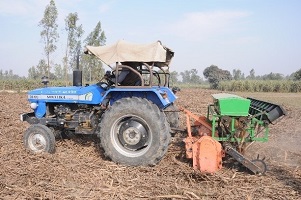Residue burning is a major issue in northern Indian Plains under rice-wheat and sugarcane-wheat cropping systems. The burning of crop residue causes a huge loss in terms of precious nutrients, soil health deterioration, noxious impact on the environment and global warming. Rotary Disc Drill (RDD) has been developed at ICAR-Indian Institute of Wheat and Barley Research (IIWBR), Karnal, for direct seeding of crops under anchored and loose crop residue in different crops for which Patent (202111009839) has been filed.


The machine falls under active type implement category i.e. PTO operated implement and comprises of rotary cutting unit with Soil Razor disc blades mounted at front followed by seeding attachment with double disc furrow openers at rear of the machine and works on triple disc mechanism. The Soil Razor discs in rotary cutting unit rotate at a speed of 380–400 rpm at standard PTO speed (540±10 rpm). The machine can be operated with dual clutch enabled tractor of at least 45 HP. The machine works effectively for direct seeding of crops in rice residue (anchored + loose residue load up to 8 t ha-1) and sugarcane trash (residue load up to 10 t ha-1) covered fields. The capability of machine to work in a relatively moist residue makes it advantageous over the existing direct seeding machines, which allows its use in the early morning and late evening. The RDD machine has a mechanism for direct seeding of various crops including wheat, rice, soybean, pea, barley, gram, soybean, and pigeonpea. It has a field capacity of 0.4-0.5 ha h-1 and specific fuel consumption of 12-15 L ha-1 depending upon the soil conditions and residue load. By the direct sowing of wheat under rice residue with RDD, input cost of about Rs. 4200 per hectare can be saved in addition to 120-130 kg ha-1 lesser CO2 emissions over conventional tillage practice.
During 2020-21 to 2022-23, RDD machine was demonstrated at farmers’ field under participatory mode for wheat seeding in rice-wheat and sugarcane-wheat rotations in Karnal district (Haryana) and Shamli district (Uttar Pradesh).The direct seeding of wheat under crop residue with RDD provided similar or higher yield with 60-65% reduction in fuel cost over conventional practice. This technology is very useful for farmers engaged in rice-wheat and sugarcane-wheat crop rotations. It allows the farmers to take an additional crop of wheat or other pulse crop like moong bean and to earn more profit through increased copping intensity in sugarcane based systems. The direct seeding of wheat into sugarcane trash advances sowing of wheat crop and it will help in increasing wheat area particularly in sugarcane based cropping system where wheat sowing is delayed.
(Source: ICAR-Indian Institute of Wheat and Barley Research, Karnal)








Like on Facebook
Subscribe on Youtube
Follow on X X
Like on instagram